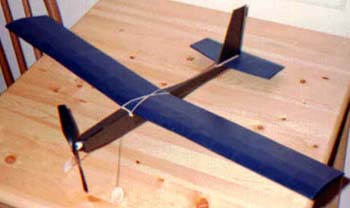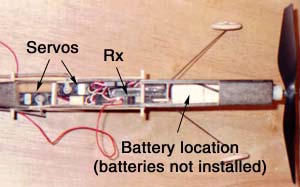
[Micro IFO] [Micro Kolibri] [Minor] [Trenton Terror] [Kits]
1st Attempt is my initial entry into the electrified RC airplane world. Once I had everything (or had everything on order) needed to construct an electric RC plane, I set to work on 1st attempt. Its ready to fly weight ended up being 5.1oz (145g). I little heavier than I had hoped, but for my first try I didn't think it was too bad. Here is a summary of the specifics:
| Plane characteristics | Radio and motor | |||
|---|---|---|---|---|
| Wing span: 81cm (32in) | Component | Type | Wt (g) | |
| Wing cord: 11cm (4.5in)(constant) | Rx | FMA Micro 2000 | 22.1 | |
| Wing loading: 15.5g/sq.dm (5.1oz/sq.ft) | Servos | 2 @ Cirrus CS-20BB | 2x9.0 | |
| Fuse length: 56.5 (22.25in) | ESC | JMP Type 7 | 2.1 | |
| Control: 3 channels (rudder, elevator, throttle) | Battery Pack | 7-cell 50mAh NiCd | 25.9 | |
| Materials: balsa and tissue | Propulsion | VL HY-50D and P-2 prop | 24.0 | |
| Ready to fly weight: 145g (5.1oz) | Total wt | 91.0 | ||

"1st Attempt", my first electric powered plane.
Construction details:
The wing and tails of 1st Attempt are made of balsa sticks and tissue.
The fuselage is 1/16 in (1.6mm) sheet balsa covered with tissue with
a foam board spacer in the tail boom (too heavy!). The control
linkage is tie wire, the landing gear supports are steel music wire
and the wheels are spruce with a 1.25 in. (32mm) diameter.
Here is a close up to show where the servos, Rx and batteries (batteries not in plane in picture) are located in the plane. The wing is rubber banded on and there is a hatch just in front of it, both the wing and the hatch have been removed in the photo. You can see the prop at the far right of the image and just behind it is a white nut that holds the motor/gear box/prop assembly in place.

Close up of radio gear and motor installation.
Flight characteristics:
Now, how does it fly? Unfortunately, not very well... I took 1st
Attempt out for its first test drive on a calm morning. I found a
fairly large patch of grass and gave it a toss with no throttle.
After tossing it a couple of times and getting it trimmed out, on the
next toss I gave it some throttle. It flew okay (I think my piloting
skills need some work I am used to flying gliders). I landed it after
a couple of seconds and then tried a runway take off. After
accelerating for about 2-3 yards (2-3m) it lifted off the ground and
climbed reasonably well. The HY-50D had no problems powering the
plane, but the batteries drained pretty quickly. I was, however,
using full throttle almost continuously for these test flights. As
for duration for "normal" flight I can't really say, since I retired
the plane before I took out a stopwatch. After a couple of more test
flights the next morning with recharged batteries, I decided that my
rudder was not as big as it should be. The plane didn't like to turn
even with full rudder. Since one of my goals in making this plane was
to keep weight at a minimum I decided to retire 1st Attempt instead of
rebuilding it, and proclaim it a learning experience.
[Micro IFO] [Micro Kolibri] [Minor] [Trenton Terror] [Kits]
|
|